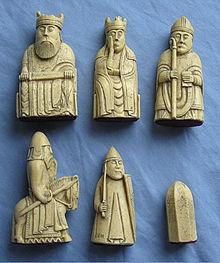
CHESS PIECES AND RULES
Shapes of pieces[edit]
Under Christianity, the shapes of the pieces, originally Islamic nonrepresentational (see piece values in shantranj), changed. Carved images of men and animals reappeared. The shape of the rook, originally a rectangular block with a V-shaped cut in the top, changed; the two top parts separated by the split tended to get long and hang over, and in some old pictures look like horses' heads. The split top of the piece now called the bishop was interpreted as a bishop's mitre or a fool's cap.
By the mid-12th century, the pieces of the chess set were depicted as kings, queens, bishops, knights and men at arms.[43]Chessmen made of ivory began to appear in North-West Europe, and ornate pieces of traditional knight warriors were used as early as the mid 13th century.[44] The initially nondescript pawn had now found association with the pedes, pedinus, or the footman, which symbolized both infantry and loyal domestic service.[43]
Names of pieces[edit]
The following table provides a glimpse of the changes in names and character of chess pieces as they crossed from India through Persia to Europe:[45][46]
| Sanskrit | Bengali | Persian | Arabic | Turkish | Latin | English | Spanish | Portuguese | Italian | French | Catalan |
|---|---|---|---|---|---|---|---|---|---|---|---|
| Raja (King) | Raja(King) | Shah | Malik | Şah | Rex | King | Rey | Rei | Re | Roi | Rei |
| Mantri (Minister) | Mantri(Minister) | Vazīr (Vizir) | Wazīr/Firz | Vezir | Regina | Queen | Reina/Dama | Dama | Regina | Dame | Dama/Reina |
| Gajah (war elephant) | Hati | Pil | Al-Fīl | Fil | Episcopus/Comes/Calvus | Bishop/Count/Councillor | Alfil/Obispo | Bispo | Alfiere | Fou | Alfil |
| Ashva (horse) | Ghora (horse) | Asp | Fars/Hisan | At | Miles/Eques | Knight | Caballo | Cavalo | Cavallo | Cavalier | Cavall |
| Ratha (chariot) | Nowka | Rokh | Qal`a/Rukhkh | Kale | Rochus/Marchio | Rook/Margrave/Castle | Torre/Roque | Torre | Torre/Rocco | Tour | Torre |
| Padati (footman/footsoldier) | Shoinnya | Piadeh | Baidaq/Jondi | Pion | Pedes/Pedinus | Pawn | Peón | Peão | Pedone/Pedina | Pion | Peó |
The game, as played during the early Middle Ages, was slow, with many games lasting for days.[13] Some variations in rules began to change the shape of the game by 1300 AD.[47] A notable, but initially unpopular, change was the ability of the pawn to move two places in the first move instead of one.[47]
In Europe some of the pieces gradually got new names:
- Fers: "queen", because it starts beside the king.
- Aufin: "bishop", because its two points looked like a bishop's mitre; In French fou; and others. Its Latin name alfinus was reinterpreted many ways.
Early changes to the rules[edit]
Attempts to make the start of the game run faster to get the opposing pieces in contact sooner included:
- Pawn moving two squares in its first move. This led to the en passant rule: a pawn placed so that it could have captured the enemy pawn if it had moved one square forward was allowed to capture it on the passed square. In Italy, the contrary rule (passar battaglia = "to pass battle") applied: a pawn that moved two squares forward had passed the danger of attack on the intermediate square. It was sometimes not allowed to do this to cover check.[48]
- King jumping once, to make it quicker to put the king safe in a corner. (This eventually led to castling.)
- Queen on its first move moving two squares straight or diagonally to a same-colored square, with jump. (This rule sometimes also applied to a queen made bypromoting a pawn.)
- The short assize. ("assize" = "sitting") Here the pawns started on the third rank; the queens started on d3 and d6 along with the queens' pawns; the players arranged their other pieces as they wished behind their pawns at the start of the game. This idea did not endure.[18]
Other sporadic variations in the rules of chess included:
- Ignoring check from a piece which was covering check, as some said that in theory (in the diagram on the right), Bxe7 would allow Rxc8 in reply.[

